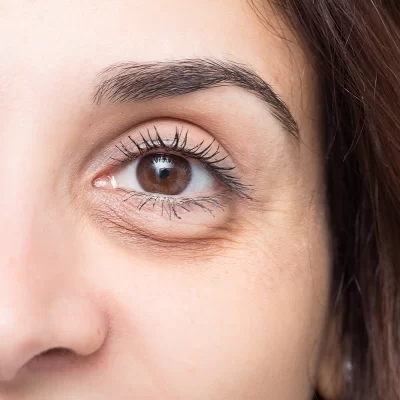Bags under the eyes - the cause
- What are under-eye bags and how do they differ from dark circles?
- How does lifestyle affect the formation of under-eye bags?
- Are under-eye bags the result of genetics or the aging process?
- What diseases can bags under the eyes indicate?
- What do bags under a child's eyes mean?
- When does swelling under the eyes require a consultation with a doctor?
- How can you reduce or eliminate under-eye bags?
What are under-eye bags and how do they differ from dark circles?
Under-eye bags are primarily caused by swelling, often resulting from fluid retention. Another reason for their formation may be displaced fat tissue, creating small hernias. This is then a structural problem known as periorbital edema.
Dark circles under the eyes are a completely different issue, often manifesting as skin discoloration or hyperpigmentation. They occur due to the visibility of blood vessels through thin skin or excessive melanin production.
Unhealthy lifestyle often leads to the formation of unsightly under-eye bags. Their appearance is associated with several key factors that disrupt the body's natural balance:
- Retaining fluids,
- Chronic fatigue, stress, and lack of sleep,
- Harmful habits such as smoking and excessive alcohol consumption, resulting in toxin accumulation and skin dehydration,
- Improper diet, including excess salt (which promotes water retention) and vitamin deficiencies (weakening skin condition),
- Excessive exposure to UV rays, which damage the skin.
The main causes of the formation of unaesthetic bags under the eyes are genetic predispositions and natural aging processes of the skin. Inherited traits can affect the structure of the eye socket, which promotes the accumulation of fluid or excess fatty tissue in this delicate area.
Over the years, the skin gradually loses collagen and elastin, leading to its sagging. Additionally, the muscles and connective tissue weaken, ceasing to effectively support the subcutaneous fat tissue. As a result, it shifts, creating characteristic puffiness.
Swelling under the eyes often signals more serious health problems, not just local ones. It can indicate systemic problems that disrupt fluid balance in the body, leading to visible swelling. The causes of swelling under the eyes can be diverse and include:
- Kidney or liver diseases,
- Hypothyroidism,
- Diabetes,
- Iron deficiency anemia,
- Heart diseases, including high blood pressure,
- Allergies,
- Conjunctivitis,
- Circulatory and lymphatic system disorders,
- Dermatomyositis,
- Hormonal fluctuations that promote water retention and accumulation of metabolic waste products.
Bags under the eyes in children, similar to adults, often result from:
-
genetic traits,
-
fatigue,
-
lack of sleep,
-
allergies (e.g. food allergies, hay fever),
-
parasitic infections (e.g. pinworm infection),
-
kidney problems.
If swelling in a child persists, worsens, or is accompanied by other concerning symptoms, be sure to consult a pediatrician.
If bags under your eyes are often harmless, in certain situations they require consultation with a doctor. You should consult with a specialist if:
-
Sudden swelling has appeared,
-
Pain, itching, or redness accompany the bags,
-
The swelling does not disappear after rest or worsens over time,
-
Changes in urination occur,
-
You feel general weakness,
-
Rapid weight gain has occurred,
-
You have breathing difficulties.
Such symptoms may indicate serious conditions that require prompt diagnosis and treatment.
Effective reduction of under-eye bags requires choosing the right therapy. Often, the problem stems from daily habits, allergies, as well as genetic predispositions or aging. To reduce under-eye bags, the following can help:
- Ensuring an adequate amount of sleep,
- Following a healthy, low-salt diet,
- Providing the body with proper hydration,
- Avoiding stimulants,
- Using cold compresses under the eyes,
- Taking medications (e.g., antihistamines for allergies),
- Utilizing aesthetic medicine procedures, such as blepharoplasty (for advanced genetically conditioned or age-related changes).

